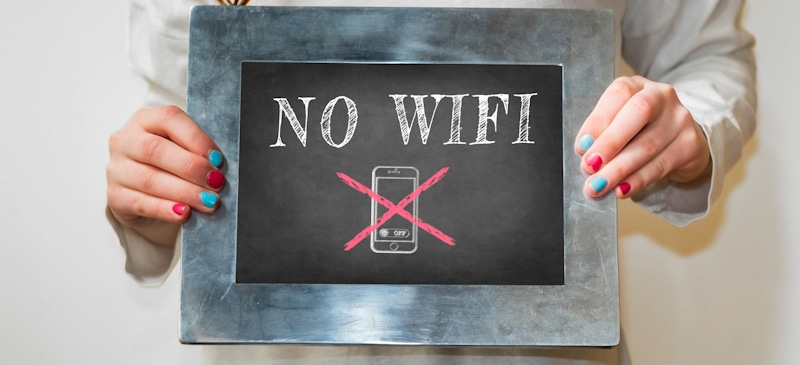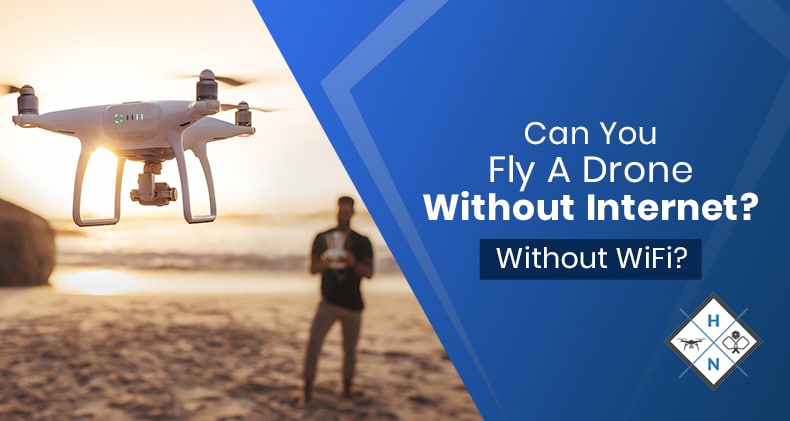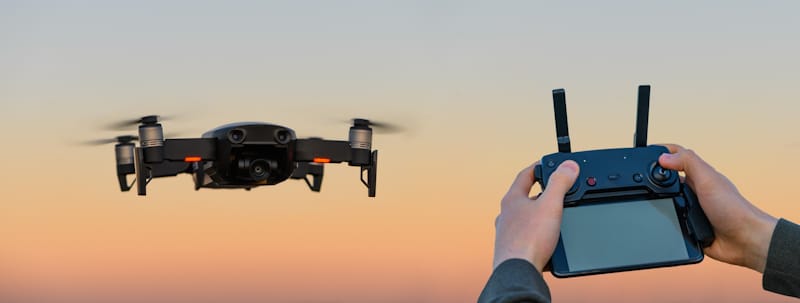Flying a drone has become an activity that many people enjoy doing in their free time. However, some people would like to know if they're able to use an old tablet or phone to fly their drone. This question arises because they want to know if you can fly a drone without an internet or WiFi connection.
It is possible to fly your drone without a WiFi signal or an internet connection. In fact, if you're using your phone or tablet to fly your drone it's recommended that you place your phone in do not disturb mode so that you can make sure you aren't interrupted with notifications or phone calls.
Flying a Drone Without Cellular Service or WiFi
You should know that it's easy to fly a drone without cellular service or WiFi. You don't even need a GPS signal to be able to fly a drone manually. Of course, it's important to understand that you'll have a lot of features that you won't be able to use (e.g. flight information) if you choose to fly your drone this way.

Most of today's consumer-level drones can determine their location simply by using a GPS signal. Therefore, you really don't need to have an internet connection available whenever you want to fly your drone as long as you can clearly see it while you're flying. If you use a GPS signal to fly your drone, you won't be flying it manually. As such, your drone will be able to hover in place whenever you need it to do so.
Unfortunately, GPS isn't included in many of the early models of drones or in the ones that are "toys." This is because many of these drones were manufactured prior to when it was common to include GPS in drones. Toy models don't have this capability because it'd be too expensive.
Understanding What GPS Is
It's important to understand that a GPS signal and an internet connection are two different things. When your drone has a GPS signal it'll be able to receive location information but it'll still need an internet connection to be able to receive other types of information. This doesn't mean that a GPS signal isn't helpful. There are several things this signal can do for you, including:
- Helping you maintain a steady flight
- Holding a consistent hover even in windy conditions
- Navigating between waypoints
- Stopping you from flying higher than intended (e.g. ensuring that you don't accidentally break the 400-foot ceiling)
- Creating a digital flight log for your record-keeping
- Finding your drone if you happen to crash
Do You Need Internet for GPS to Work?
GPS is considered by many people to be one of the biggest advancements when it comes to drone technology. Today you'll find that GPS serves many different functions for drones. Among one of its primary uses is making drones safer and more convenient to fly. The nice thing is that you can still use GPS if you don't have an internet or WiFi connection. In fact, if you don't have either of these connections you'll need GPS to fly your drone. Fortunately, most drones now have these receivers. Typically they're located in both the drone and the receiver but sometimes they're only in the drone itself. In this case, you'll be using your phone to collect the GPS signal when you need to use it for your drone's various functions (e.g. follow me, dynamic home point).
One of the main features that GPS is used for today is geofencing. This is a great feature because it'll prevent your drone from flying into someplace that's either unsafe or illegal. In this way, you can think of a geofence as a virtual fence that will prevent you from getting into trouble with the law. Some of the other features that you'll need GPS for include:
- Recording your exact location when you took a photograph
- Updating your drone's home point location so that if you lose connection with it from your remote control your drone will still return to you: This is probably its most important use since you never want to lose your drone. When you have GPS you don't have to worry about this because your drone can provide you with regular reports regarding its location in case it does crash.
- Providing you with "Follow Me" mode in case you want your drone to be able to follow you around
Why Drones Need the Internet or WiFi
While you can quite easily fly your drone without ever having an internet or WiFi connection, this doesn't mean that you'll be able to fully enjoy doing so. There are still some things that your drone will need to have an internet or WiFi signal to do.
Drones Need Internet or WiFi to Enable Additional Features
Your drone has numerous features that won't be available if you don't have an internet or WiFi signal. For instance, you won't be able to update your maps without such a signal. This means that your location data won't be nearly as accurate as it'd be when you do have such a signal. Additionally, when you don't have internet or WiFi you won't be able to live-stream your videos to sites like YouTube and Facebook.
Drones Need Internet or WiFi to Update Maps
Whenever your drone has an internet or WiFi connection it'll be able to pull an updated map from wherever you're flying. While it's quite common to fly your drone with satellite image overlay enabled, you won't be able to do this if you don't have an internet or WiFi connection enabled. Many people compare this mode to that of using Google Maps while they're driving their car. Indeed they're both similar in that the map's information needs to be pulled from a server before it can be shown on your screen. This information will also need to be cached, especially if it's a map that you use frequently.
Most drones have a setting that'll allow you to cache a map. For instance, if you're using the DJO GO app and you look under the General Settings tab you'll find an option that says "Cache Map in the Background." With this app, you can even permanently cache the map offline. If you won't have internet or WiFi service this can come in handy as long as you remember to tell the app to cache the map of where you'll be flying while you do still have service.
Drones Need Internet or WiFi to Provide Accurate Location Information
Your internet or WiFi signal will help your device triangulate your location more accurately. This is why there will be times when you're using an app and you receive a popup notification that tells you that you should enable your WiFi connection. Although really expensive GPS modules are able to track your location with great precision, consumer-level drones aren't quite to this level yet. Therefore your drone will try to use your cellular signal and its WiFi to hone in and get you an even more accurate location. While this is something that GPS can also do, there is an added benefit to having WiFi-enabled to do this for you. You can then turn your drone's return to home feature on while you're flying. This is important because there will be occasions when the "home" spot that you've recorded before you launched your drone won't be the exact spot in which it lands. While it's typically close to there, it's even closer if you're able to have an internet or WiFi connection.
Drones Need Internet or WiFi to Live-Stream Videos
Live-streaming isn't what happens when you're sending a feed from your drone to your controller. This feed typically uses radio waves that are on the 2.4 gigahertz spectrum along with the remote control that you'll always need to have available when you're flying your drone. Here live-streaming is used to refer to sending actual, live video to a third-party site. Some people want to do this instead of merely shooting videos that they'll edit later. If this is of interest to you, then you should know that you're going to need to have either internet or a WiFi connection to make it happen. Before you even start to live-stream you really should make sure that you have an unlimited data plan or, at the very least, a lot of data available. This is important because when you're using your phone or your tablet for live-streaming at 1080p or even 720p you're going to eat through your data pretty quickly.
Recording Videos and Taking Pictures Without Internet or WiFi
One of the things that most people want to be able to do with their drones is to either record a video or take a still photograph in the area where they're flying their drone. Not only is this a lot of fun but many people are simply in awe of some of the photographs that drones have been able to capture.
While this is great, you may be concerned about the quality of the images or video if you don't have an internet or WiFi connection. Thankfully the quality of these shots won't go down under these circumstances. This is because all the footage you capture is stored on your drone's local SD card. Since the footage isn't stored online in the cloud, the quality will always remain the same.
If you're having problems capturing footage you should make sure that your drone's SD card isn't corrupted or out of storage. You should also check your drone's camera. Any drop in its quality is something you should contact the manufacturer about.
How Drones Communicate with the Remote Controller
When you're controlling a drone there's a signal being sent from it to its remote controller. Typically this is a pulse position modulation (PPM) signal. What this means is that the drone is receiving a digital pulse that gives the drone all of the instructions it needs. The drone understands this information because the flight controller is responsible for translating it into control signals that are then delivered to each of your drone's individual motors.
The transmitter module transforms your controller's signal into an electromagnetic oscillation. This is a radio signal that's sent through the air by a transmission standard. While it's in the air the receiver converts the signal back into the control signal. The strength and frequency of these signals are regulated by law which is why organizations like the police have different frequency bands. However, there are some frequency bands that are commonly used by the public. These include industrial, scientific, and medical (ISM) radio bands. The International Radio Regulations (IRR) regulate their frequencies.
Some of the most important transmission standards include:
- Bluetooth is used by some of the "toy" drone models. This gives these drones a flight range of about 110 yards (100 m) but things like WiFi or microwave ovens can interfere with them. This is why you can purchase a controller so that it can transmit data to your mobile phone via Bluetooth. The mobile phone must then communicate with the drone via WiFi.
- Direct-sequence spread spectrum (DSSS) or frequency-hopping spread spectrum (FHSS) is are standard and inexpensive radio remote controllers. These remote controllers can be used by different drones. They typically have a range of one mile (~ 2 km).
- 27.12 MHz or 40.68 MHz are analog data transmission frequency bands that are commonly used to control drones. If you choose to use this option, it's important to make sure that you separate the video signal from the control signals. For instance, you may decide that you want to use a 2.4-GHz video transmission and a 40.68-MHz analog control signal.
Conclusion
You really don't need to have an internet connection or WiFi to be able to fly your drone today. It's a good idea for you to have GPS but even this isn't necessary. A skilled pilot can fly their drone manually without the use of any of these technologies.
Shawn Manaher loves to play with new toys and dive into new hobbies. As a serial entrepreneur, work definitely comes first but there is always room for hobbies.



